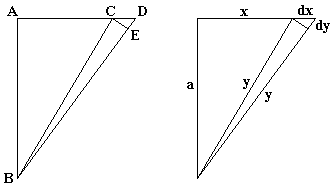
http://www.cut-the-knot.org/pythagoras/

This one is by Michael Hardy from University of Toledo and was published in The Mathematical Intelligencer in 1988. It must be taken with a grain of salt.
Let ABC be a right triangle with hypotenuse BC. Denote
y·dy - x·dx = 0,
which after integration gives y² - x² = const. The value of the constant is
determined from the initial condition for
It is easy to take an issue with this proof. What does it mean for a triangle
to be
| x² + a² = y² | |
| (x + dx)² + a² = (y + dy)² |
which, after subtraction, gives
y·dy - x·dx = (dx² - dy²)/2.
For small dx and dy, dx² and dy² are even smaller and might be neglected,
leading to the approximate ![]()
The trick in Michael's vignette is in skipping the issue of approximation.
But can one really justify the derivation without relying on the Pythagorean
theorem in the first place? Regardless, I find it very much to my enjoyment to
have the ubiquitous equation
![]()
An amplified, but apparently independent, version of this proof has been published by Mike Staring (Mathematics Magazine, V. 69, n. 1 (Feb., 1996), 45-46).

Assuming Δx > 0 and detecting similar triangles,
Δf / Δx = CQ/CD > CP/CD = CA/CB = x/f(x).
But also,
Δf / Δx = SD/CD < RD/CD = AD/BD = (x + Δx) / (f(x) + Δf) < x/f(x) + Δx/f(x).
Passing to the limit as Δx tends to 0+, we get
df / dx = x / f(x).
The case of Δx < 0 is treated similarly. Now, solving the differential equation we get
f 2(x) = x² + c.
The constant c is found from the boundary condition